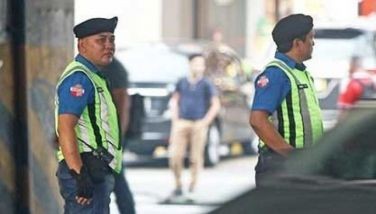Spain, Vatican may help restore churches
CEBU, Philippines - Experts and church officials are looking to the Spanish government, the Vatican as well as to the ordinary faithful to defray the huge cost of restoring the centuries-old Catholic churches damaged by the powerful earthquake in Cebu and Bohol.
Masses continued at the quadrangle of the damaged Basilica del Sto. Niño de Cebu against the backdrop of a crane hovering over its coral-made belfry now chopped by the magnitude 7.2 earthquake that struck Tuesday.
Its side entrance collapsed yesterday due to the hundreds of aftershocks hitting the region.
Apart from the basilica, other damaged churches include the Church of San Pedro Apostol, Loboc, Bohol; Church of Our Lady of Light, Loon, Bohol; Santissima Trinidad Parish, Loay, Bohol; Church of Our Lady of the Immaculate Conception, Baclayon, Bohol; Church of Our Lady of the Assumption, Dauis, Bohol; San Nicolas Church, Dimiao, Bohol; Santa Cruz Parish Church, Maribojoc, Bohol; Cebu Metropolitan Cathedral, Cebu city; and St. Catherine's Church, Carcar City-all constructed during the Spanish era.
"We are still continuing our assessment of the damage but right now what we're doing is palliative, and we are also securing the sites because there are so many precious artifacts underneath," Ludovico Badoy, Executive Director of the National Historical Commission of the Philippines (NHCP), told The STAR.
"Restoration is going to be a very expensive undertaking and this needs the combined effort of all," he said. "I think the Spanish government would want to participate, it's just a matter of us seeking their help."
Badoy, accompanied by representatives of the Department of Public Works and Highways and private restoration experts, has been making the rounds of the damaged historical structures.
Several teams from the NHI were also dispatched to Bohol, which was the hardest hit. Local authorities in Bohol and Cebu were given strict instructions not to touch the rubble until the experts have arrived.
Using chalk and colored markers, experts and workers have begun the painstaking task of accounting for every brick and stone in the rubble of the basilica to salvage them and help ensure that original material is used as much as possible in the restoration.
"These churches tell our history, strengthened the faith of Catholics among us. Many of us were baptized here, married here, and our elders interred here," Badoy said.
Cebu Archbishop Jose Palma said help might be forthcoming from Pope Francis, who is expected to issue any time soon a formal message of sympathy for the victims of the earthquake.
Palma said he was able to speak twice to Msgr. Giuseppe Pinto, the Papal Nuncio to the Philippines or the pope's envoy, to apprise him of the situation.
He said Pinto was expected to send a report to the pope on the damage to the churches.
He said the Vatican's historical and cultural office would likely coordinate with the Catholic Bishops' Conference of the Philippines' on the Cultural Heritage of the Church to map out a plan to restore the churches.
Palma said the importance of restoring the damaged churches could not be overemphasized as "they serve as a bridge from the past to our present and to the future."
"We know the faithful from all walks of life would support this undertaking," he told The STAR.
Cebu Rep. Ace Durano, a former tourism chief, said even if the government would want to fully restore the churches, it could only do so much.
"There is not only the financial constraints, but this could be questioned by some because the Constitution states that the government cannot favor a particular religious group," Durano said.
He said if foreign entities, such as the Spanish government, would want to donate funds, they would likely be coursed through the religious orders that run the churches.
Durano, however, said government assistance on some churches can be easily justified on the grounds that they are heritage or cultural sites.
Bohol Rep. Arthur Yap strongly pushed for "funding round" with international finance agencies for the restoration.
"These churches are really owned by the entire Filipino people," Yap said. — Paolo S. Romero, Philippine Star News Service (FREEMAN)
- Latest
























